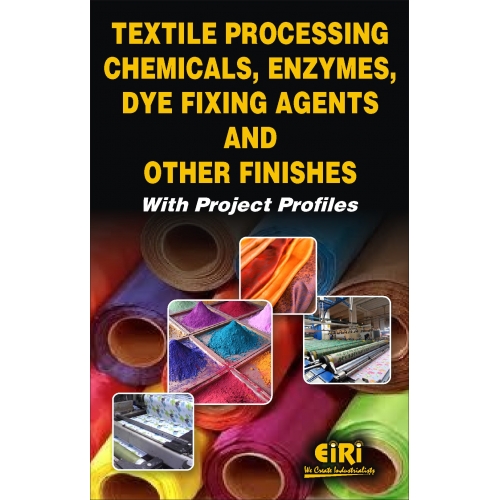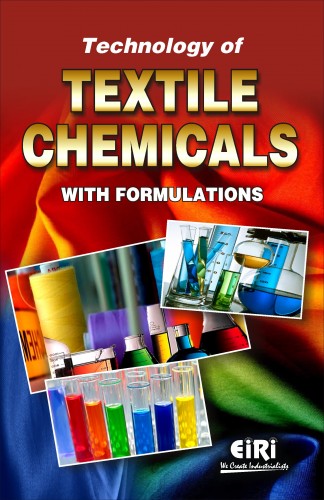Description
TEXTILE PROCESSING CHEMICALS, ENZYMES, DYE FIXING AGENTS AND OTHER FINISHES WITH PROJECT PROFILES
- Enzymes used in Textile Processing
- Enzymes as proteins
- Biocatalyst Enzymes
- Nomenclature
- Activities of enzymes
- Induced fit model
- Enzymatic Reactions
- Mechanism
- Enzymes used in Textile
- Amylase
- Pectinase for Enzymes
- Catalase
- Cellulase
- Laccases (copper containing oxidase enzymes)
- Lipase (Water sluble enzyme)
- Glucose oxidase enzyme
- Xylanase
ENZYMATIC BIOPROCESSING
- Utilization
- Enzymes-Natural Biocatalysts
- Inotex enzymatic products for bast fibre extraction improvement
- Treatment of Mechanical opening & cleaning
- Processing of Fiax, Hemp and Linseed
- Enzymatic enrichment of dew retting process
- REA 120 machinery concept for fibres opening and cleaning
- Typical conditions
- Repair of retted fibres
- Repair of worst quality dew retted fibres with Texazym SCW
- Material friendly cottonization
- Effect of different commercial enzymes on the hemp fibre fineness improvement
- Device for wet processing of loose fibres (tows for example)
- Effect of different commercial enzymes on the improvement of hemp fibre fineness (fibre diameter) & tenacity
- Processing of flax scutching tow (low quality) with Texazym BFE
- Processing of linseed (variety Amon) tow with Texazym BFE
- Application of enzymes (utilize fibre from linseed straw)
- Laroche cottonization line
- Comparison of stem biomass yield of different linseed varieties
- Linen eco yarms and pretreatment of flax roving
- Enzymatic processing of linseed stems, cultivar Amon
- Improvement of whiteness after enzymatic bio retting for eco yarm production comparison of Texazym SCW with other types of enzymes
- Results of industrial trials with enzymatic treatment of flax rovings
- Technical bast fibre applications
- Results
ANTIBACTERIAL AGENTS
- Introduction
- textile antimicrobial treatments
- Antimicrobial finishing agents
- Quaternary ammonium
- Triclosan
- Metallic salts
- The bacterial counting test for comparing the antibacterial activity of metallic ioaded cotton
- Plasma sputtering
- The schematic view of Plasma sputtering system
- The inhibitin zone of S aureus around untreated and copper coated cotton
- Chitosan
- The bacterial counting test for untreated wool with E coli
- The bacterial counting test for untreated wool with S aureus
- The bacterial counting test for silver coated wool with E.Coli
- The bacteriala counting test for silver coared wool with s aureus
- Quantitative Evaluation Against S. Aureus (Shake Flask Method)
- Comparison of bacterial reduction before and after coating cotton fabrics with chitosan PBA particles or chitosan solution
- Cyclodextrin
- TEM micrographs of chitosan PBA particles stained for an appropriate period with 2% PTA solution
- Mechanisms of antimicrobial finishes
- Practical biocides
- Evaluation of antimicrobial finishes
- The future
- Comparison between different AATCC test methods
TEXTILE FIBRES PROCESSING ENZYMES
- Biotechnology
- Production of enzymes
- Role of enzymes in textile processing
- Amylases
- Textile desizing
- Pectinases
- Enzymatic scouring
- Cellulases
- Denim finishing
- Pilling and fuzz fibre removal
- Serine profeases subtilisins
- Enzymatic treatment of wool
- Cysterine proteases papain
- Degumming of silk
- Transgulutaminases (TGs)
- Treatment of leather and wool
- Lipases/esterases cutinase
- Surface modification of synthetic fibres
- Nitrilases and nitrile hydratases
- Surface modification of polyacrylonitrile (PAN)
- Laccases
- Decolourization of textile bleaching and dyes
- Catalases
- Treatment of bleach liquor
- Conclusions and fuure prospects
FABRIC FINISHING
- Theory
- Crosslinking Cellulose
- Crease Recovery
- Definitions
- Cellulose Crosslinkers
- Reactions of Formal dehyde
- Formalion of Hydroxymethyl Derivatives
- Reactions of Hydroxymethyl
- Resin Formers (Aminoplasts)
- Urea/Frmaldehyde (U/F)
- Malamine/Formaldehyde
- Synthesis of Hexamethoxymethyl Melamine
- Important Features
- Reactants
- Dimethylolethylene Urea (DMEU)
- Dimethylol-4/5 Dihydroxyethylene Urea (DMDHEU)
- Carbamates
- Controlling Formaldehyde
- Atmospheric Formaldehyde
- Fabrics Formaldehyde
- Free Formaldehyde
- Formaldehyde Release
- Responsible for HCHO Release
- Fabric pH and Formaldehyde Release
- Effect of pH on CH2O Release
- Technology of Reducing Frmaldehyde Release
- Scavengers
- Modified DMDHEU
- Methylated DMDHEU
- Diethyleneglycolated DMDHEU (ULf)
- Alkylated DMDHEU
- Non formaldehyde Dp Finishes
- Formaldehyde Release Comparison of Modified DMDHEU
- dimethyl-4-5, Dihydroxyethylene UREA (DMeDHEU)
- Synthesis
- Important Features
- Butanetetracarboxylic Acid (BTCA)Sodium Hypophosphite
- Sodium Phosphate
- Reactive Silicones
- Liquid Ammonia
- Durable Press Catalyst
- Bronsted Acids
- Ionization Constant
- Hydrogen Ion Concentration
- Latent Acids
- Lewis Acids
- Important Considerations
- Specific Catalyst and their use
- Free Acids
- Latent Acids
- Metal Salts
- Hot Catalyst
- Buffers and Alkalinity
- Buffers
- Alkalinity
- Chemical Process
- Methylolation
- Alkylation of N-Methylol Compounds
- Proton Activated Alkylation
- Cellulose Crosslinking with Lewis Acids
- Alkoxylated Products (Reaction)
- Crosslinking with Alkoxykated N-Methylol Cmpounds
- Stability of Crosslink to Laundering
- Hydrolysis of Cellulose Crosslinks
- Properties Fabric
- Durable Press Performance
- Important Points
- Relationship of DP Performance versus DMDHEU Add on
- Different Crosslinkers
- Tensile, Tear and Abrasion Resistance
- Crease Recovery versus Resin Concentration
- Important to Remember
- Physical properties versus Add-on
- Crease Recovery versus Curing Temperature
- Important to Remember
- Crease Recovery versus Temperature of Cure and Resin type
- Other Fabric Properties
- Shrinkage
- Yellowing
- Chlorine Resistance
- Fabric Odor
MODIFICATION
- Handbuilders
- Non-durable
- Starch
- Polyvinyl Alcohol
- Durable
- Thermosetting Polymers
- Thermoplastic Polymers
- Suitable Monomers/Suitable Monomers/Comonomers
- Fabric Softeners
- Coefficient of Friction
- Viscosity
- Important Points to Remember
- Selection of Softener
- Raw Material Availability
- Fat Derived Raw Materials
- Softener Classifications
- Anionic Softeners
- Sulfates
- Fatty Alcohol Sulfates
- Sulfated Fatty Acid Esters
- Sulfonated Fatty Amides and Esters
- Sulfoethyl Fatty Esters (IGEPON A)
- Sulfoethyl Fatty Amides (IGEPON)
- Properties of Anionic Softeners
- Advantages
- Disadvantages
- Cationic Softeners
- Adsorption on Fiber Surface
- Amine Functional Cationic Softeners
- Cationic Amine Salts
- Fatty Aminoesters
- Fatty Amidoamides
- Imidazolines
- Quaternary Ammonium Salts
- Synthesis of Monofatty Quats
- Properties of Cationic Softeners
- Advantages
- Disadvantages
- Nonionic Softeners
- Polyethylene Emulsions
- Composition of Polyethylene Emulsions
- Typical Composition
- Ethoxylated Nonionic Softeners
- Silicone Chemistry
- Reaction of Monochlorosilanes wiith Water
- Reaction of Dichlorosilanes with Water
- Reaction of Trichlorosilanes with Water
- Reaction of Hydogen silances with Water
- Silicone Softeners
- Dimethyl Fluids
- Methylhydrogen Fluids
- Amino Functional Silicones
- Orientation of Dimethyl Fluids on Fiber Surface
- Epoxy Functional Silicones
- Properties
- Advantages
- Disadvantages
FINISHES
- Chemistry of Wetting
- Spreading of Liquids on Smooth Surfaces
- Work of Adhesion
- Critical Surface Tension
- Critical Surface Tension of Teflon
- Critical Surface Tensions of Smooth Surfaces
- Critical Surface Tension of end Groups
- Contact Angles in Real Systems
- Repellent Finishes
- Hydrocarbon Hydrophobes
- Paraffin Waxes
- Wax Emulsion Composition
- Fiber Reactive Hydrocarbon Hydrophobes
- N-Methylol Stearamide
- Pyridinium Compounds
- Resin Formers
- Metal Complexes
- Silicone Water Repellents
- Application to Fabrics
- Advantages and Disadvantages
- Fluorochemical Repellents
- Effect of Fluorination on Critical Surface Tension
- Commercial Products
- Effect of Perfluoro Side Chain
- Polymer Backbone Effect
- Relationship between Oil Repellency and Length of Perfluoroalkyl Side Chain
- Add on
- Extenders
- Oil Repellency versus Fluorochemical Add-on
- Finishing of Repellent with Fluorochemicals
- Rainwear
- Typical Rainwear Formulation
- Stain and Soil Retardancy
- Uphotstery Anti soil Finishes
- Treatments of Carpet Anti soil
- Fluorochemical Finishes
- Other Carpet Antisoil Treatments
- Light Scattering Fibers
- Stain Blockers
SOIL RELEASE FINISHES OF FABRICS
- Soils
- How fabrics are Soiled
- Removal of soil
- Particulate Soil
- Oily Soils
- Roll up Mechanism
- Rolling up Process of Soil Release
- Rollup Thermodyamics
- Fiber Oil Detergent Interaction
- Fiber
- Effect of Hydrophobic Surfaces on Soil Release
- Soil Release Chemicals
- Acrylic Soil Release Finishes
- Polymethacrylic Acid
- Pol(methacrylic acid) Soil Release Finishes
- Effect of Crosslinking
- Methacrylic Acid Ethyl Acrylate Co-Polymers
- Mechanism
- 70/30 Methacrylic Acid Ethyl Acrylate SR Finish
- Effect of Crosslinking
- Practical Considerations & Fabric Properties
- Dual Action Fluorochemical Soil Release
- Polymer Composition
- Method
- Practical Considerations & Fabric Properties
- Fluorochemical Soil Release Agent
- Flip Flop Mechanism
- Polyoxyethylene Copolymers
- Polyoxyethylene Type SR Finish
- Sulfoisophthalic Acid Copolymers
- Sulphoisophthalic Type SR Agent
- Practical Considerations & Fabric Properties
- Most Important Points to Remember
- Non Ionic Detergents
- Effect of Surfactant Type on Soil Removal From Polymer Films
- Soil Release Tests
- Release Point
- Rp Determinations
- Roll up of Oil in Detergent Solutions
- Application of Rp Measurements
- Results Versus Residual Soil
- Geometry of Yams and Fabrics
FLAME RETARDANT FINISHES
- Details of Combustion
- Flammability Parameters for Fibers
- Combustion of Cellulose
- Combustion Cycle
- Cellulose Pyrolysis Products
- Other Pryolysis Products
- Flame Retardancy
- Feedback Mechanism
- Combustion Feedback Mechanism
- Char Frmation
- Parameters that Characterize Burning Textiles
- How Certain Elements Work
- Boron
- Phosphorus & Nitrogen
- Halogens
- Flame Retardant Chemicals & Processes for Cellulose
- Non Durable
- Boric Acid/Borax
- Dimmonium Phosphate and Phosphoric Acid
- Sulfarmic Acid and Ammonum Sulfamate
- Durable
- Tetrakis(hydroxymethyl) phosphonium Derivatives
- Tetrakis(hydroxymethyl) phosphonium Hydroxide (THPOH)
- Fyrol 76
- Phosphonic and Phosphoric Acid Derivatives
- Retardant Method for Specific Fibers
- Rayon Additives
- Polyeste
- Decabromodiphenyl Oxide (DBDPO)
- Tris(2-3 Dibromopropyl) Phosphate (TRIS)
- Antiblaze 19T
- Nylon
- Thiourea urea Melamine
- Halogenated Systems
- Polyester/Cotton Blends
- Decabromodiphenyl Oxide Antimony Oxide
- Wool
- Dyebath Exhaustible Finishes
- Titanium Complexes
- Hexafluoro Zircnates
THERMAL AND SORPTION TECHNOLOGY
- Thermal behaviour
- Materials for flame protection
- Flame resistant Cellulosics
- Thermal and flame retardant properties of some fibres
- Flame retardant Polyester
- Flame retardant Acrylic
- Armids
- Phenolics
- Modacrylic
- Aim of our work
- Experimental
- Materials
- Fibres used for thermal and sorption study
- Methods
- Thermal analysis
- Differential Scanning Calorimetry (DSC)
- Sorption study
- Dynamic Sorption Analysis
- Water Retention Value
- Visualization of burned fibers
- Results and discussion
- Thermal analysis
- Mass changes by TGA
- TGA graph of cellulosics
- TGA plots of synthetic FR fibers
- TGA plots of melamine & modacrylic fibers
- TGA plots of other high performance
- Energy changes by DSC
- DSC Plots of cellulosics
- DSC Plots of synthetic FR fibers
- Sorption study
- Water vapor sorption
- DSC plots of melamine & modacrylic fibers
- Sorption isotherms of cellulosics
- Sorption isotherms of synthetic FR fibres
- Water retention values (WRV)
- WRV of standard and modified cellulosics
- WRV of synthetic FR fibers
- Visualization of burned fibers
- SEM images of FR fibers before and after burning
- conclusions and Outlook
VOLATILE PHOSPHORUS
- Experimental
- Materials
- Formulation and Application of Back coating
- Flame retardants used and their chemical characteristics
- Flammability Measurement
- Generic back coating formulation
- Thermal Analytical Procedures
- Results & Discussion
- Phosphorus Mobility in back coated Formulations
- TGA responses of Antiblaze CU, tributyl phosphate (TBP), triphenyl phosphate (TPP), and triphenylphosphene oxide (TPPO) under nitrogen
- Phosphorus Retention in Fabric Chars
- Flammability testing results of back coated cotton and polyprpylene fabrics after a 40 Deg C water soak treatment
- TGA and LOI results for back coated 360 pergm cotton fabrics
- Difference between actual and theoretical phosphorus contents (P) of charred back coated cotton fabric
- Phosphorus concentrations and residual weights for back coated cotton samples containing 250 dry parts Antibiaze MCM in the formulation
- Phosphorus concentrations and residual weights for back coated cotton samples containing 250 dry parts Antiblaze NH in the formulation
- Phosphorus concentrations and residual weights for back coated cotton samples containing 250 dry parts Antiblaze CU in the formulation
- Phosphorus concentrations and residual weights for back coated cotton samples containing 100 dry parts Antiblaze CU in the formulation
- Addition of Volatile Components to APP
- Flammability testing for mixed flame retardant formulations (prewater soak)
- Phosphorus concentrations and residual weights for back coated cotton samples containing 250 dry parts Fyrol 51 in the formulation
- Phosphrus concentrations and residual weights for back coated cotton samples containing 100 dry parts Fyrol 51 in the Formulation
- Durability results and flammability testing (postwater soak)
CHELATING AGENTS
- Synthetic Chelating Agents
- Ligno Sulfonates
- Humic or Fulvic acids
- Organic Acids
- Advantages
- Disadvantages
- Protein (Amino Acids)
DYE FIXING AGENTS
- Application Examples
ANTI STATIC AGENT WITH SPIN FINISH
- Examples
- Method of production of amine alkoxylates
- Conversion to dialkyl sulphate quaternaries
- Conversion to EO/PO block copolymer
- heat Stability
- Ester based
- Mineral oil based
OTHER IMPORTANT FINISHES
- Antipill Fabric Finishing
- Mechanism of Pilling
- Pill Formation
- Pill Build up
- Factors Affecting Pill Formation
- Fiber variables
- Yarn Variables
- Fabric Construction
- Preparaton and Dyeing
- Fabric Finishing
- Film Forming Binders
- Durable Press Reactants
- Fabric Softeners
- Singing and Shearing
- Heat setting
- Summary
- Antistatic Finishes
- Causes of Static
- Problems Caused by Static Electricity
- Mechanism of Control
- Static Fliminators
- Antistatic Agents
- Fiber Polymer modications
- Non Durable Antistatic Agents
- Cationic Materials
- Non Ionic Materials
- Durable Antistatic Finishes
PLANT ECONOMICS OF ACRYLIC COPOLYMER EMULSION
- Plant and Machnery
- Fixed Capital
- Raw Materials
- Total Working Capital/Month
- Total Capital Investment
- Turn Over/Annum
PLANT ECONOMICS OF ANTI FOAMING AGENT (SILICONE BASED) FOR DISTILLERY, SUGAR INDUSTRY, PAPER PLANT ETC.
- Plant and Machinery
- Fixed Capital
- Raw Materials
- Total Working Capital/Month
- Total Capital Investment
- Turn Over/Annum
PLANT ECONOMICS OF CATIONIC SOFTENER
- Plant and Machinery
- Fixed Capital
- Raw Materials
- Total Working Capital/Month
- Total Capital Investment
- Turn Over/Annum
PLANT ECONOMICS OF CHELATED ZINC (ZN-EDTA) 12%
- Plant and Machinery
- Fixed Capital
- Raw Materials
- Total Working Capital/ Month
- Total Capital Investment
- Turn Over/Annum
PLANT ECONOMICS OF CHELATED ZINC EDTA & CHELATED COPPER EDTA
- Plant and Machinery
- Fixed Capital
- Raw Materials
- Total Working Capital/Month
- Total Capital Investment
- Turn Over/Annum
PLANT ECONOMICS OF DYE FIXING AGENTS (LOW FORMALDEHYDE FOR PIGMENT PRINTING LIKE ACRAFIX ML)
- Plant & Machinery
- Fixed Capital
- Raw Materials
- Total Working Capital/Month
- Total Capital Investment
- Turn Over/Annum
PLANT ECONOMICS OF DYE FIXING AGENTS (NON FORMALDEHYDE DYEFIXING AGENT FOR DIRECT/REACTIVE PRINTING LIKE TINOFIX FRD OF M/S CIBA GAIGY)
- Plant and Machinery
- Fixed Capital
- Raw Materials
- Total Working Capital/Month
- Total Capital Investment
- Turn over/Annum
PLANT ECONOMICS OF DYE LAVELLING AGENT
- Plant and Machinery
- Fixed Capital
- Raw Materials
- Total Working Capital/Month
- Total Capital Investment
- Turn over/Annum
PLANT ECONOMICS OF ENZYME USED FOR DENIM CLOTH AND GARMENT WASHING
- Plant and Machinery
- Fixed Capital
- Raw Materials
- Total Working Capital/Month
- Total Capital Investment
- Turn over/Annum
PLANT ECONOMIC OF ENZYMES BIO TECHNOLOGY BASED
- Plant and Machinery
- Fixed Capital
- Raw Materials
- Total Working Capital/Month
- Total Capital Investment
- Turn over/Annum
PLANT ECONOMICS OF NON IONIC SURFACTANTS WETTING AGENTS
- Plant and Machinery
- Fixed Capital
- Raw Materials
- Total Working Capital/Month
- Total Capital Investment
- Turn over/Annum
PLANT ECONOMICS OF SILICONE EMULSION FOR TEXTILE
- Plant and Machinery
- Fixed Capital
- Raw Materials
- Total Working Capital/Month
- Total Capital Investment
- Turn over/Annum
PLANT ECONOMICS OF SIZING SOFTENER (SILK SIZING LIQUID WATER SOLUBLE)
- Plant and Machinery
- Fixed Capital
- Raw Materials
- Total Working Capital/Month
- Total Capital Investment
- Turn over/Annum
PLANT ECONOMICS OF TEXTILE & FINISHING AGENTS
- Plant and Machinery
- Fixed Capital
- Raw Materials
- Total Working Capital/Month
- Total Capital Investment
- Turn over/Annum
PLANT ECONOMICS OF TEXTILE PRINTING PASTE (GUM)
- Plant and Machinery
- Fixed Capital
- Raw Materials
- Total Working Capital/Month
- Total Capital Investment
- Turn over/Annum
Engineers India Research Institute (EIRI) is a renowned name in the industrial world for offering technical and financial consultancy services.
EIRI services are:
- Detailed Feasibility Reports
- New Project Identification
- Project Feasibility and Market Study
- Identification of Lucrative Industrial Project Opportunities
- Preparation of Project Profiles / Pre-Investment and Detailed Feasibility Studies,
- Market Surveys / Studies, Market Survey Cum Detailed Techno-Economic Feasibility Reports
- Project Reports in CD Roms
- Identification of Plant /Process/Machinery and Equipment, Industrial General Guidance for setting up new industrial projects.
Our most up-to-date and Technologically Advanced Industrial Project Reports, categorized with respect to Financial Outlays and Sector – wise Classification are immensely useful for :
- Existing Small or Medium Scale Industrialists facing competition from large houses
- Young Entrepreneurs dreaming to start their own industrial enterprise
- Young Graduates and Professionals wishing to begin their career
- Industrialists interested in Debottlenecking their capacities & New Product – Lines
- Large Industrial Houses pursuing Expansion, Growth and Diversification Plans






